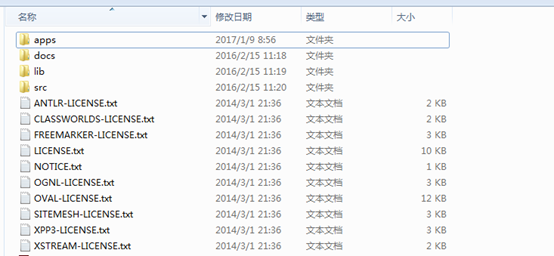一、Struts2的获取
Struts的官方网站为:http://struts.apache.org/
下载完Struts2的jar包,解压,Struts2资源包的目录结构如下图:

- apps目录下包含了官方提供的Struts2应用示例.各示例均为war文件.
- docs 目录下是官方提供的Struts2文档,可以通过index.html页面进行访问
- lib 目录下是Struts2的发行包以及依赖包
- src目录下是Struts的源代码
二、Struts2的使用
(1)导包:新建java Web项目,添加struts2的jar 文件。Struts2的依赖的基础jar如下

(2)web.xml中配置Struts2的核心过滤器
<?xml version="1.0" encoding="UTF-8"?> <web-app version="3.0" xmlns="http://java.sun.com/xml/ns/javaee" xmlns:xsi="http://www.w3.org/2001/XMLSchema-instance" xsi:schemaLocation="http://java.sun.com/xml/ns/javaee http://java.sun.com/xml/ns/javaee/web-app_3_0.xsd"> <display-name></display-name> <welcome-file-list> <welcome-file>index.jsp</welcome-file> </welcome-file-list> <!-- Struts2的核心过滤器:注意,要放在所有过滤器的最后 --> <filter> <filter-name>struts</filter-name> <!-- 早期的Struts的核心过滤器是:org.apache.struts2.dispatcher.FilterDispatcher 而在2.1.3之后使用下面的过滤器类 --> <filter-class>org.apache.struts2.dispatcher.ng.filter.StrutsPrepareAndExecuteFilter</filter-class> </filter> <filter-mapping> <filter-name>struts</filter-name> <url-pattern>.action</url-pattern> </filter-mapping> </web-app>
(3)编写一个测试的实体类。如下:
package entity; public class Student { private String stuNo; private String stuName; public String getStuNo() { return stuNo; } public void setStuNo(String stuNo) { this.stuNo = stuNo; } public String getStuName() { return stuName; } public void setStuName(String stuName) { this.stuName = stuName; } }
(4)新建一个类继承ActionSupport,类里面定义私有地属性(非方法内),可以是任意类型的数据或对象,给这些属性添加set方法用于传递值到界面,添加get方法用于取界面的数据。例子如下:
package controNer; import com.opensymphony.xwork2.ActionSupport; import entity.Student; public class StudentControNer extends ActionSupport{ private Student stu = new Student(); public String show(){ stu.setStuName("张三"); stu.setStuNo("1001"); return "showStudent"; } public String changeStudent(){ System.out.println(stu.getStuNo()); System.out.println(stu.getStuName()); String stuName=stu.getStuNo(); stu.setStuNo(stu.getStuName()); stu.setStuName(stuName); return "changeStudent"; } public Student getStu() { return stu; } public void setStu(Student stu) { this.stu = stu; } }
(5)在src目录下新建一个Struts的xml文件,如下
<?xml version="1.0" encoding="UTF-8"?> <!DOCTYPE struts PUBLIC "-//Apache Software Foundation//DTD Struts Configuration 2.3//EN" "http://struts.apache.org/dtds/struts-2.3.dtd"> <struts> <package name="default" namespace="/" extends="struts-default"> <action name="queryStudent" class="controNer.StudentControNer" method="show"> <result name="showStudent">index.jsp</result> </action> <action name="changeStudent" class="controNer.StudentControNer" method="changeStudent"> <result name="changeStudent">index.jsp</result> </action> </package> </struts>
在Struts配置文件中,包含以下几个元素:
- package元素用于定义Struts2处理请求的逻辑单元,name属性为必需的并且唯一,指定包的名称(被其他包引用),extends属性类似Java的extends关键字,用于指定要扩展的包
- action元素用于配置Struts2框架的”工作单元”action类,action元素将一个请求的URL(action的名字)对应到一个Action类.name必需的,用来表示action的名字;class属性可选,用于设定Action类的全限定名.
- result元素用于设定Action类处理结果后系统下一步将要做什么.name属性表示result的逻辑视图名称,必须与Action类返回的字符串进行匹配;而result元素的值表示与逻辑视图名对应的物理资源之间的映射,用来指定这个结果对应的实际资源的位置.
(6)添加一个jsp页面,用来测试
<%@ page language="java" contentType="text/html; charset=utf-8" pageEncoding="utf-8"%> <!DOCTYPE html PUBLIC "-//W3C//DTD HTML 4.01 Transitional//EN" "http://www.w3.org/TR/html4/loose.dtd"> <html> <head> <meta http-equiv="Content-Type" content="text/html; charset=utf-8"> <title>Insert title here</title> </head> <body> <form action="changeStudent.action"> <input type="text" value="${stu.stuNo}" name="stu.stuNo"> <input type="text" value="${stu.stuName}" name="stu.stuName"> <input type="submit"> </form> </body> </html>
(7)程序运行的流程说明:
首先,浏览器访问struts中action的name.action,在web.xml执行过滤器,当检测到地址栏带有.action的情况时,会调用Struts留给我们的过滤器处理方法,进入到struts的配置文件中,然后检查.action前面的字段,当字段名和某个action的name值相同时,通过action的class和method查找到继承了ActionSupport的class的类,找到里面的method的方法,进行处理,通过这个类的私有属性的get方法,就可以找到界面提交过来的同一名字同一类型的对象的值,通过set方法就可以将数据返回界面。